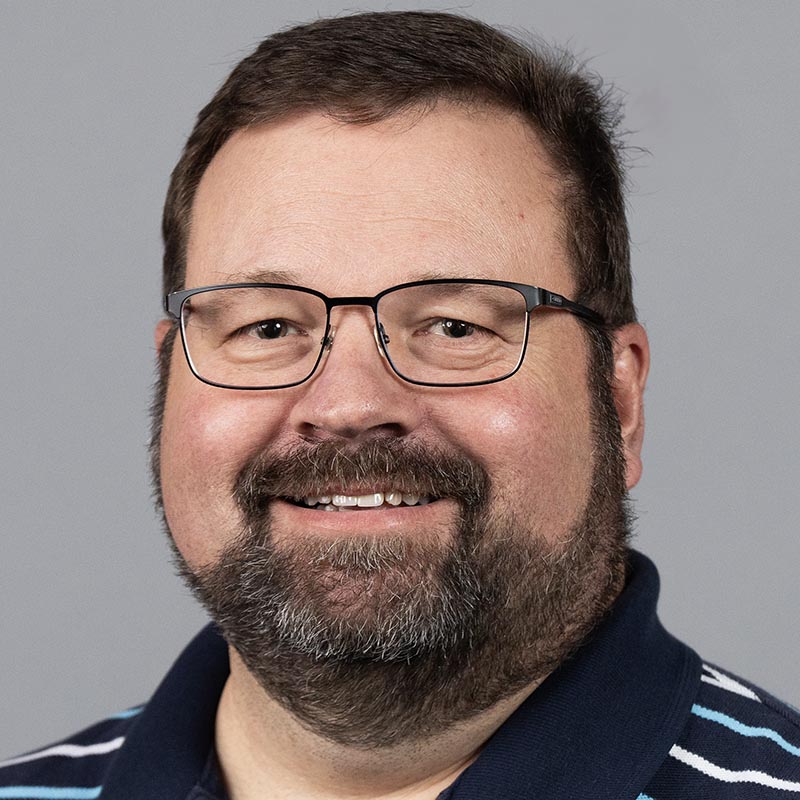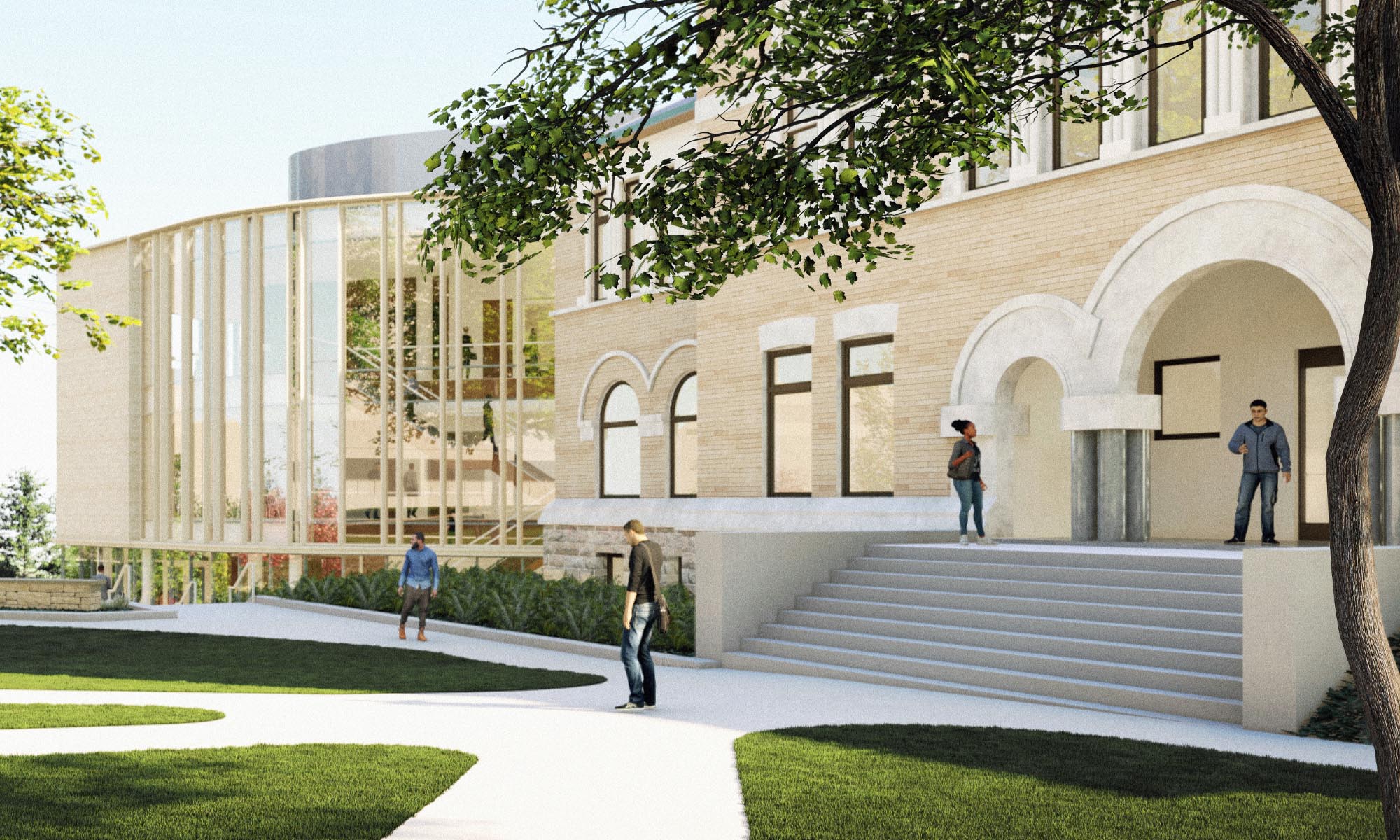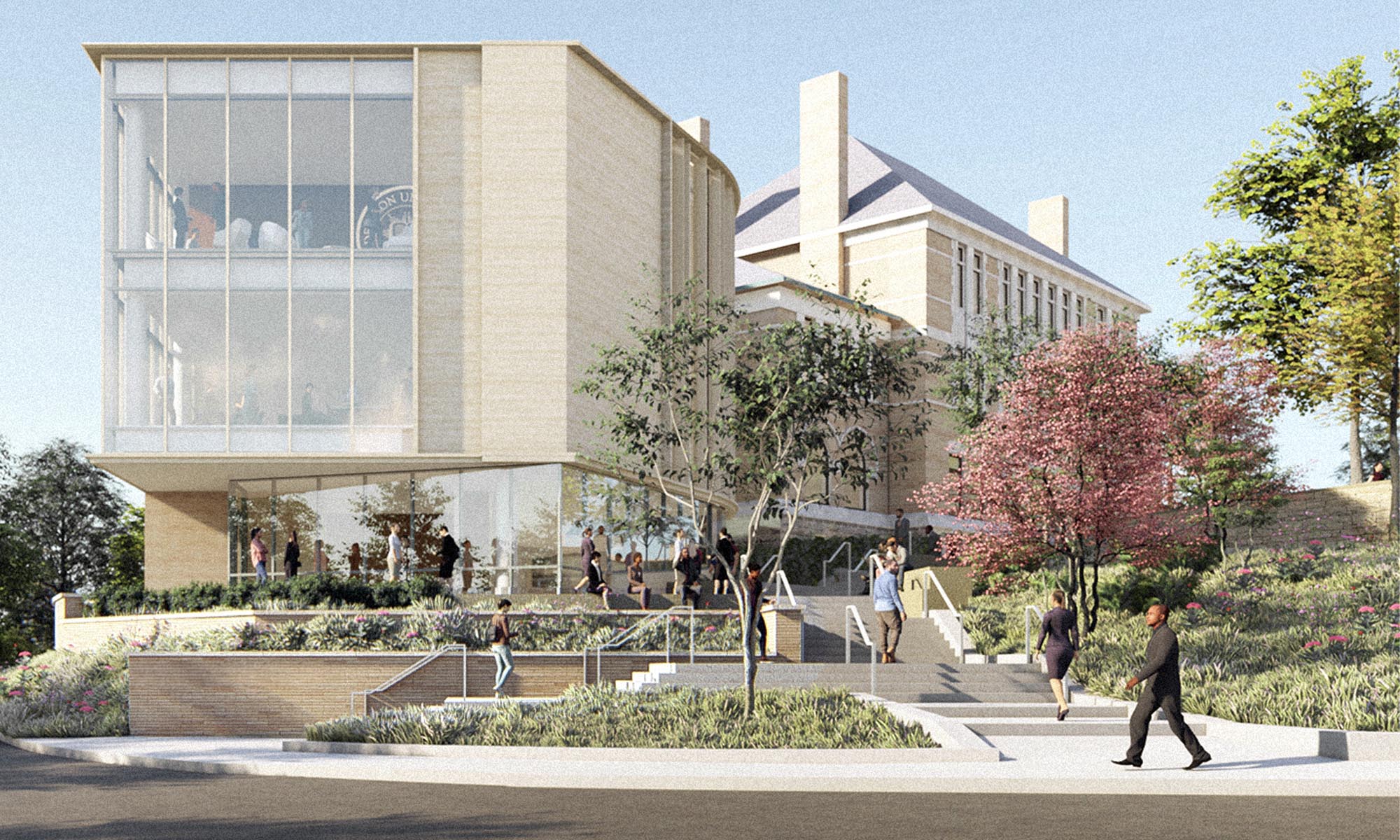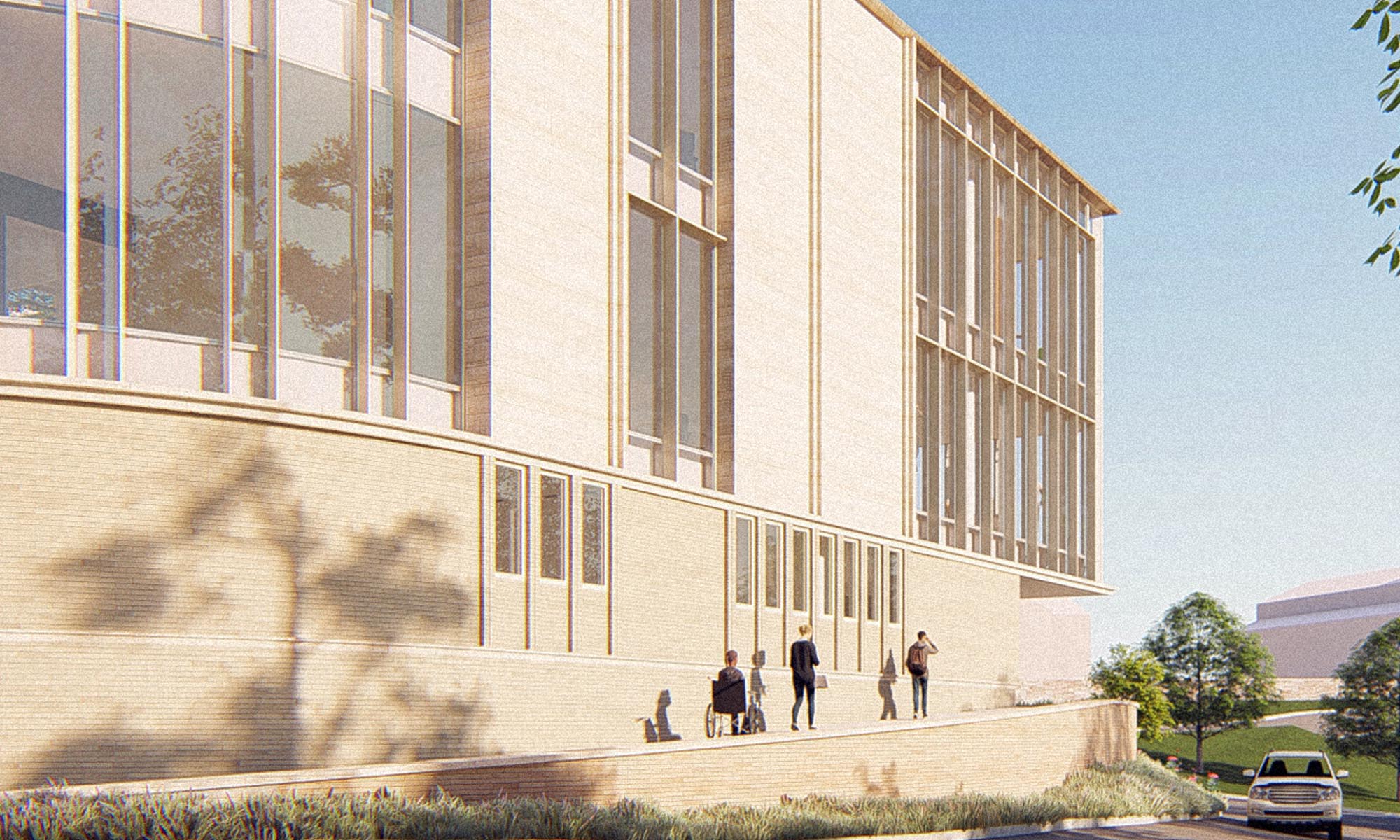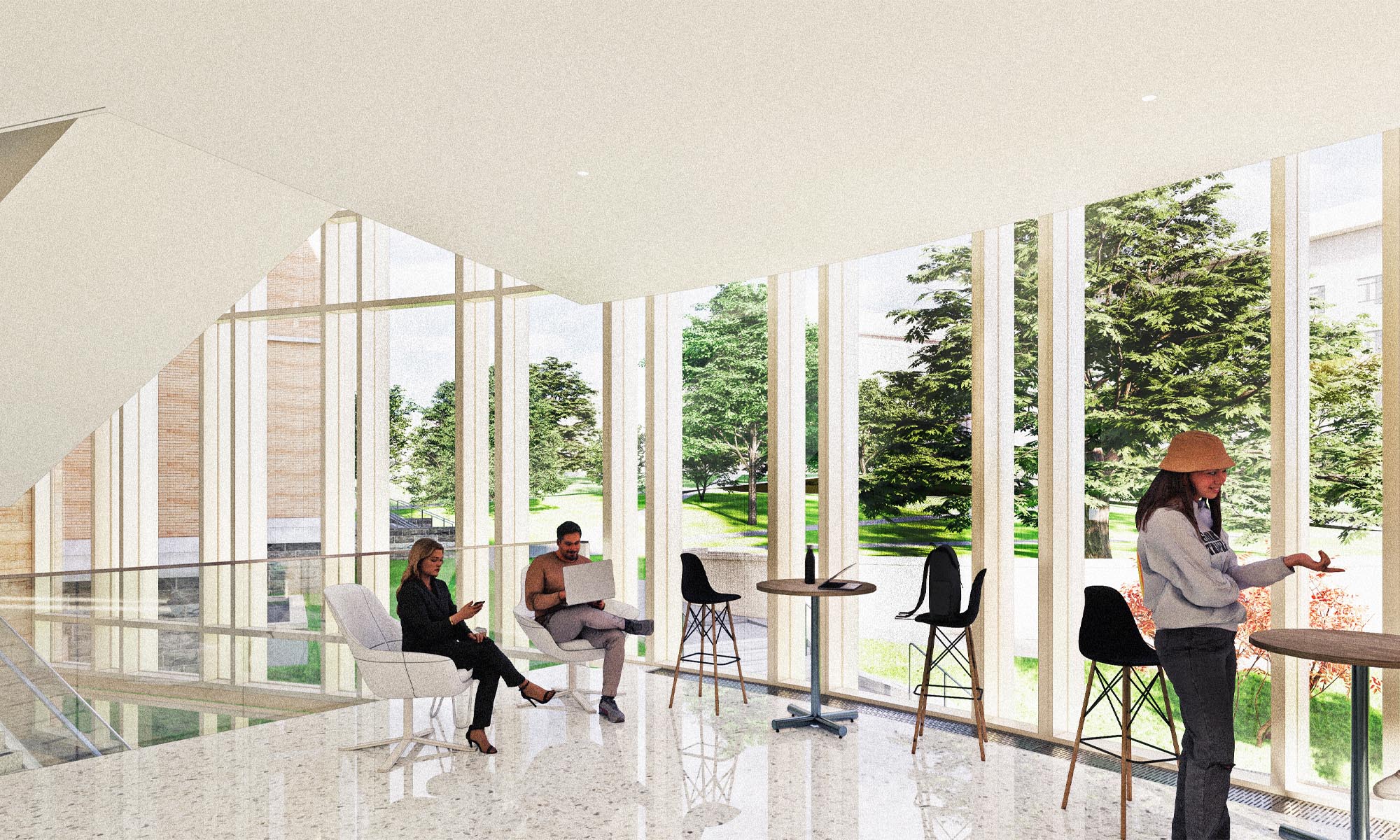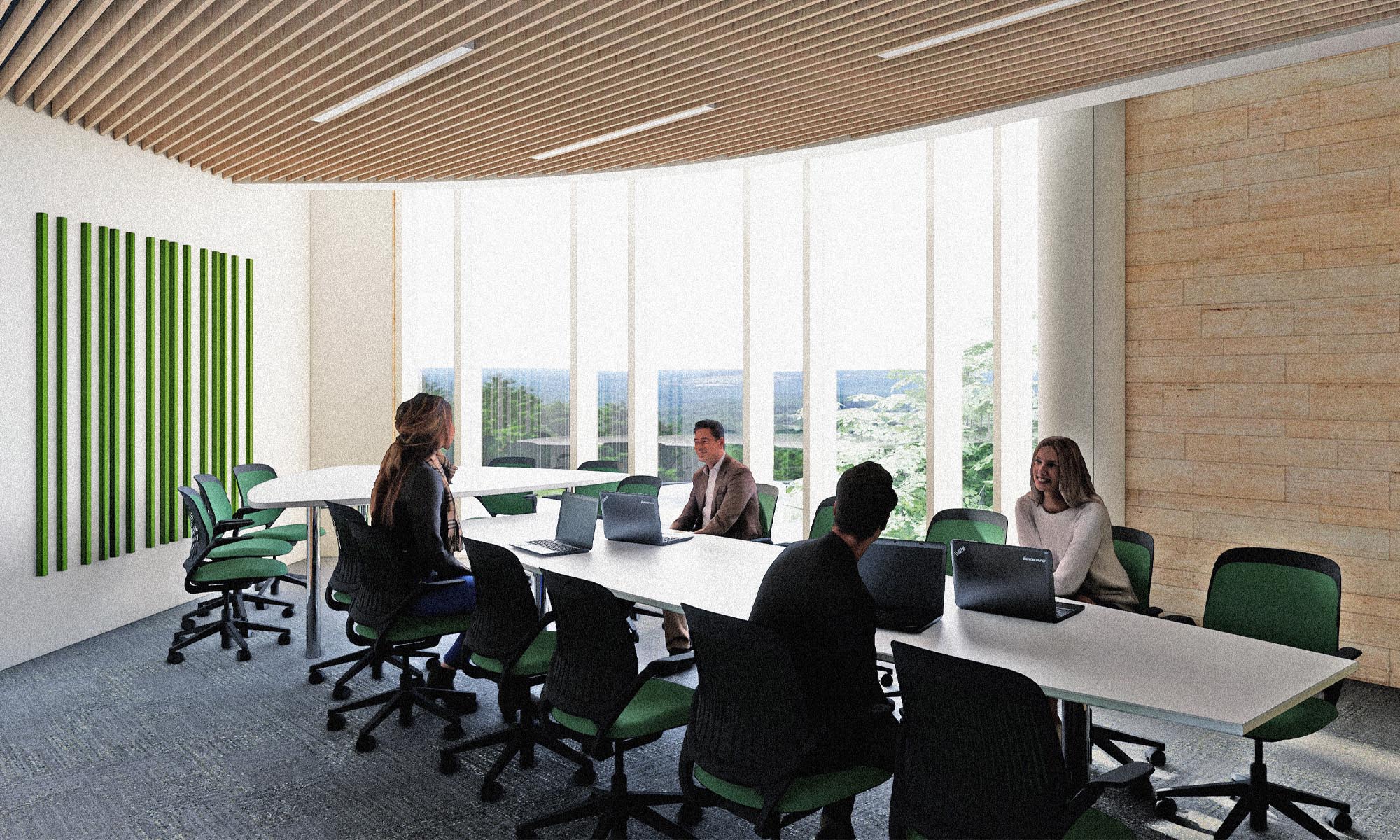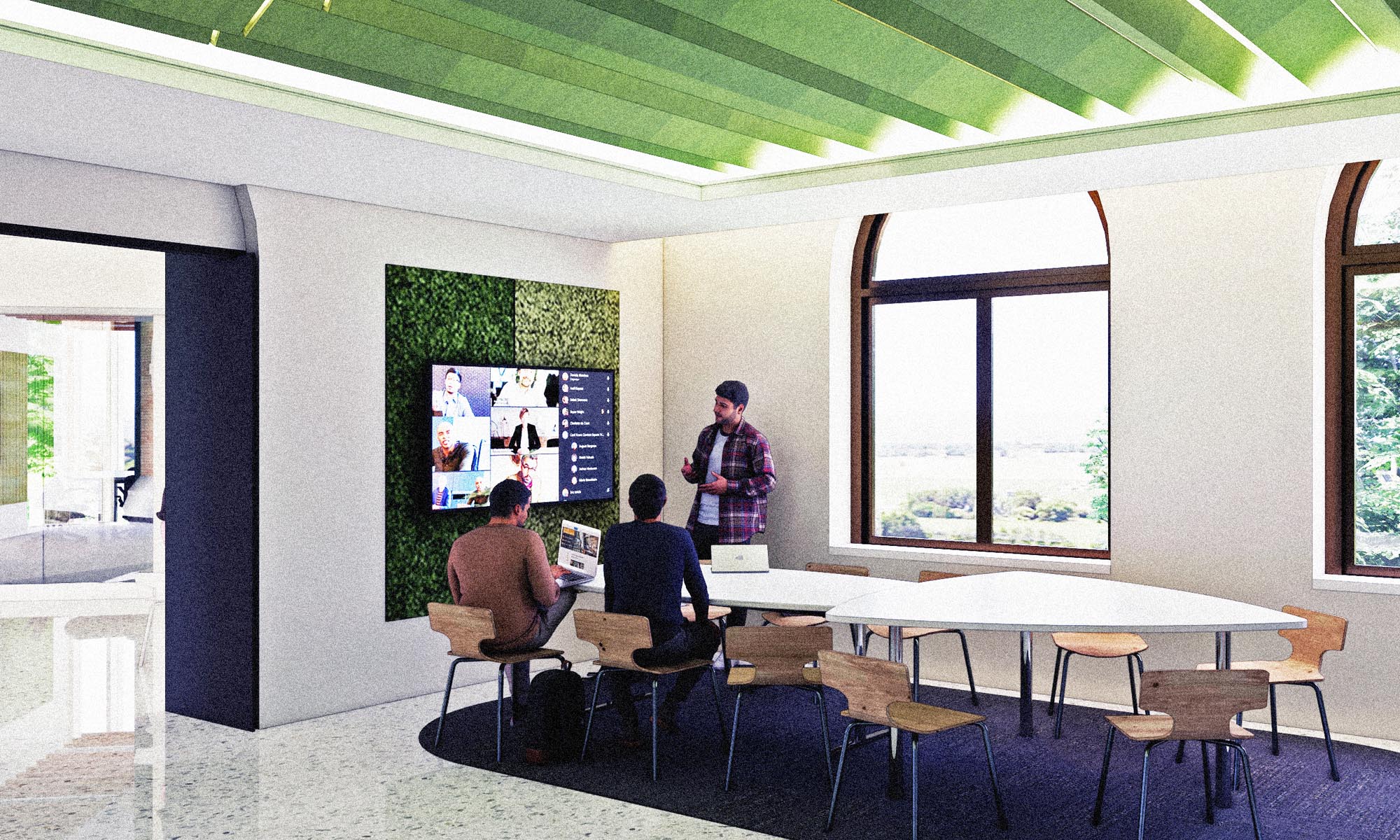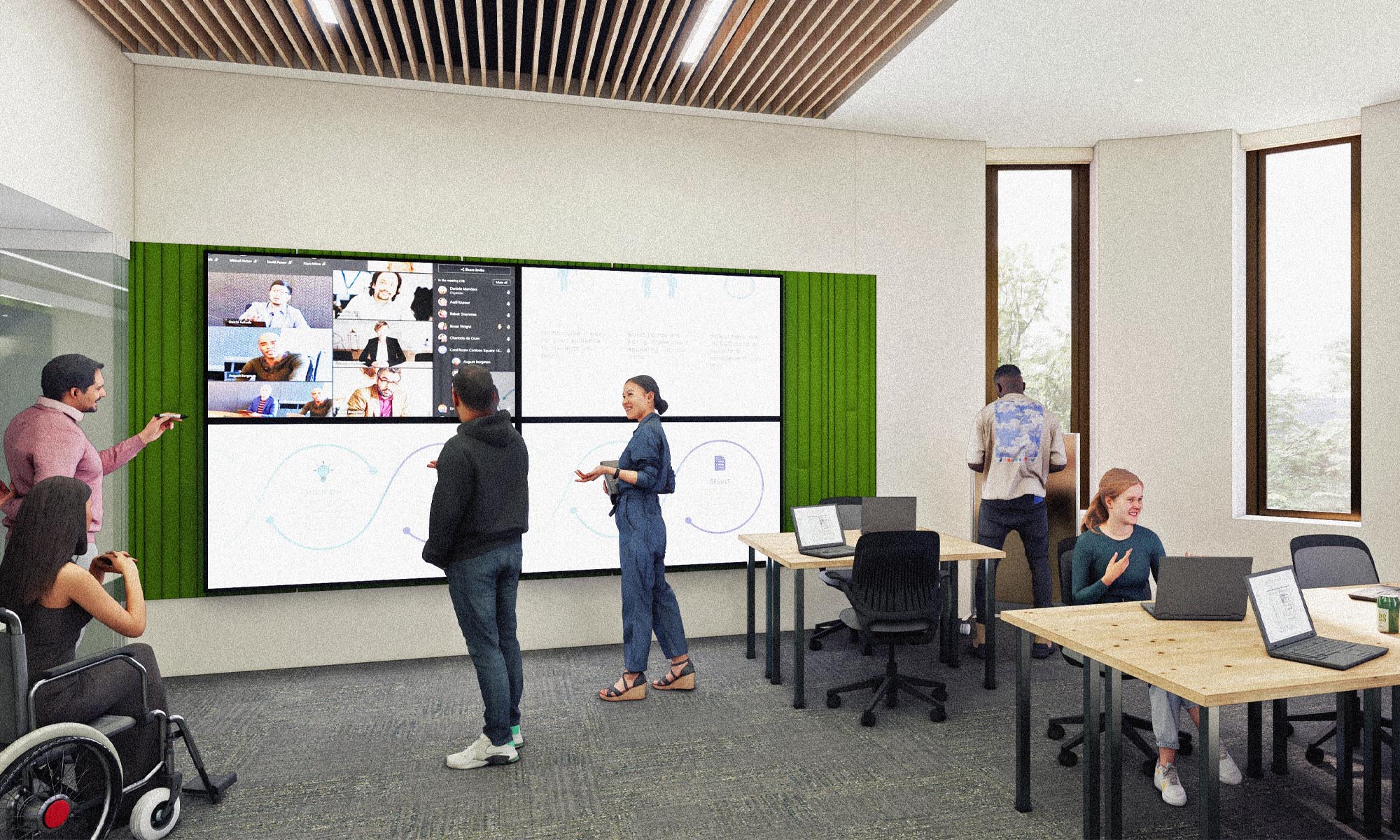New data science center is a game changer
Donors have committed $30 million to the first-of-its-kind center that will integrate the liberal arts and data science.
On a January afternoon two weeks into the Spring 2025 semester, a group of Denison donors, administrators, and faculty gathered outside Doane Hall for a groundbreaking celebration.
Students passed by on the Academic Quad, taking little notice. This was a Friday, after all, and their minds may have been on upcoming festivities of their own. It was understandable if they didn’t yet “see” the profound change manifesting inside Doane and behind the construction fencing that went up over winter break.
They’ll see it soon enough.
In fall 2024, Denison began construction to renovate and expand Doane Hall. The visionary center of learning, which will open in fall 2026, will further cement the college’s reputation as an innovator in the liberal arts and data science.
With the generosity of donors who have already committed $30 million, the renovation and expansion of one of the most prominent and historic buildings on campus positions Denison to be the first liberal arts college with a state-of-the-art campus hub devoted to integrating data across a liberal arts curriculum.
The center will house the computer science and data analytics departments and host courses such as applied mathematics, digital humanities, financial economics, and data for political research. As envisioned, it will reach far beyond those two core departments to bring students of all majors and faculty of all disciplines under one roof, giving them the technological tools and teaching the skills necessary to not only navigate but thrive in a world increasingly driven by data.
“This is a game changer,” President Adam Weinberg said at the Jan. 31, 2025, groundbreaking. “This building is a catalyst for everything that is going to go on across the college. Every student will pass through this building in different ways.”
The birth of an idea
Once completed, the renovated building will stand as a monument to Denison’s across-the-board commitment to fully preparing students for a successful launch into their lives and careers, whatever discipline they choose to pursue.
Denison has long seen the value in teaching the kinds of critical thinking skills — algorithmic thinking, statistical reasoning, data analysis — associated with emerging technologies, computer science professor Matt Kretchmar said.
“We were one of the very first liberal arts colleges to offer a computer science degree, way back in the ’70s,” he said.
In 2016, Denison became one of the first liberal arts colleges in the nation to launch a data analytics major.
The move was a strategic response to a world teeming with data and the increasing need for professionals who have the skillset to make meaningful sense of it. Today, data analytics and computer science are among Denison’s fastest-growing majors, and graduates of the programs are finding themselves in high demand.
“We’re leading in this area in the liberal arts space,” Provost Kim Coplin said. “People are following our lead.”
The vision for the major was to explore data science beyond the straight and narrow path followed by many other schools.
Denison saw the power in introducing data analytics across its curriculum, teaching students not only how to mine it but what it meant, how to use it to solve myriad problems, and how to talk meaningfully about it with others.
“Every single profession that our students will go into in the future is going to depend upon technology, data, and artificial intelligence,” Weinberg said.
“Data has to be interpreted by liberal arts graduates who know how to ask the right questions, tell stories that others can understand and engage with, and ensure that our work has an ethical core,” he said. “A liberal arts background gives data analytics its soul.”
Professor Dan Homan, the director of the data analytics program, put it this way: “We’re trying to grow the culture that understanding data is about more than just building technical expertise.”
Associate professor Sarah Supp said Denison challenges all students, regardless of major, to think about data analytics not just as a method or a means to an end but as a holistic pursuit of knowledge.
“The data analytics we teach is not only to produce software engineers or large language model coders or statisticians but really to allow our students to make those connections much more broadly,” she said.
“What makes data analytics at Denison so attractive is our focus on problem-solving,” data analytics associate professor Anthony Bonifonte said.
“We ask: What kinds of problems exist in the world? How can our students solve them, and how does data help inform their solutions in making a better society?”
Finding value in the versatility
What does that look like?
Consider the recent research by one of Bonifonte’s recent students, Jacob Eppley ’25, a mathematics and data analytics double major.
“The data analytics program was the main thing that brought me to Denison,” Eppley said. With graduation drawing near, he said, “It exceeded my expectations in a lot of ways.
“Data is everywhere, and I enjoyed how much freedom there was in the program,” Eppley said. “You can take it in any direction you want, and being able to pursue other degrees and concentrations really supports that.”
Community service is important to Eppley, and with Bonifonte’s guidance they hit upon a project that would combine data analysis with community service by assisting Together We Grow Community Gardens in nearby Newark, Ohio.
Eppley combed through available data of all kinds — population, assorted socioeconomic indicators, proximity to grocery stores and existing community gardens — to pinpoint areas of Licking County most in need of a community garden.
“We plotted all of the variables together on a map, stacked on top of each other,” he said. He identified several potential locations for new gardens and sat down with staff of the small nonprofit to choose the one that worked best within their operational constraints.
“We combined the data side of what we found with the practical, logistical side of what they can handle,” he said. “Based on our results, they’re in the process of opening a new garden that will be usable this summer.”
Eppley also demonstrated how his methods could be used to find garden sites in all of Ohio’s 88 counties. His research was published in the Undergraduate Journal of Service Learning & Community-Based Research.
“It gave me a good perspective of knowing what I want to do,” he said.
Max Wisnefski ’24 majored in data analytics at Denison, with minors in computer science and philosophy. He also has a deep appreciation of the performing arts, as reflected by his senior year research.
Wisnefski web-scraped 40 years of data to analyze the changing relationship between Tony Award outcomes and the financial success and longevity of Broadway productions.
“Having the opportunity to combine two seemingly disparate passions of mine was just really enjoyable,” he said.
Wisnefski was always good with numbers but arrived at Denison undecided on a major. When it came to data analytics, “I didn’t know that was a thing” but he figured he’d give it a shot when encouraged by Bonifonte.
“That feels very unique to Denison, this try-a-little-of-everything approach,” Wisnefski said. “That’s really valuable.”
He now works for a Columbus business, on behind-the-scenes soft-ware, coding, and related IT issues.
“It feels like a good place to launch,” he said.
“I really value the versatility of Denison’s data analytics program,” he said. “The topics students pursue end up running the gamut from economics to health care to ecology.”
A new hub
At the groundbreaking, Weinberg and Lee Sachs ’85, chair of Denison’s Board of Trustees, said the $30 million already raised by donors again highlights Denison’s deep and devoted network of alumni and friends.
“This structure will stand as a testament to the dedication, commitment, leadership, and philanthropy of some of the individuals gathered here today,” Sachs said. “And we are still not done. This is just the first milestone in our fundraising efforts.”
Purpose-built
The project will include a significant renovation of the existing, 21,750-square-foot Doane Hall and the addition of a 15,700-square-foot new wing.
In addition to anchoring the computer science and data analytics departments, the new building will give students and faculty from all academic departments access to the specialized learning spaces and technology housed within.
The center will be the hub for programs related to data science — competitions in data analytics, workshops for humanities faculty to explore data visualization, guest speakers outlining the future uses of data, regional business leaders convening to hear student presentations, and virtual conferences in data science and the liberal arts.
It will include office and research space and multi-purpose classrooms, including some specially designed for teaching coding and analytics. There will be presentation spaces, conference rooms, and a host of specialized labs serving robotics, virtual reality, and data visualization.
“It gives our faculty what they’ve needed and deserved for a long time, so they can continue to do the incredible work they’re doing, changing the lives of our students,” Weinberg said.
The center also will foster connections within the booming technology corridor emerging in central Ohio, where companies such as Amazon and Intel are investing billions within a short drive of Granville.
“These purpose-built facilities aim to enhance learning, foster transformative experiences, and adapt to future technological advancements,” Coplin said. “It’s already been a factor in terms of recruiting faculty.”
Homan said the center’s common areas, with ample windows and a wealth of natural light, will foster collaboration and innovation among the faculty and students.
“Denison has always had a highly engaged student body,” Homan said. “They are known for their entrepreneurial spirit and combining their passions in unexpected ways. I’m hoping this new building will invite more students to do that with data.”
“We’re all very excited to have dedicated space, a home for data analytics, and a place that I hope will allow more students to discover what we’re about, whether they choose to be majors or not,” Supp said.
A melding of past and future
The renovation also will restore an arrival point at the top of Presidents’ Drive based on the original 19th-century design, an approach to campus that was lost in the mid-1960s.
The addition will extend to the northeast at an angle from the existing building, and a grand exterior staircase to the Academic Quad that once filled much of what is now a sloping lawn will be rebuilt to the north of the addition.
While the interior of Doane will be modernized, the historic building’s exterior and ornate finishings will remain intact.
“We felt that the design was symbolically representative of data analytics at a liberal arts college, a meld of old and new,” Bonifonte said.
Kretchmar, a computer science professor at Denison since 1999, is excited by that too, what the reimagined Doane represents.
“This building is an outgrowth of our efforts to put Denison on the map of cutting-edge pedagogy in the liberal arts,” he said. “It’s about equipping our students to think critically and act critically in the modern world. Among the traditional liberal arts skills, which are still enormously valuable, to function in the modern world now you need to be able to make and listen to statistical arguments, sift through a data set and find the story that the data is telling, and think algorithmically and computationally.
“This project is a statement about Denison,” Kretchmar said. “About the importance of developing these skills across all students. I think we’re creating the future here.”
At the groundbreaking, Weinberg spoke of that same excitement, and how the new building underscores Denison’s strong liberal arts roots while connecting them to a future brimming with educational possibilities.
“I love that this building will be the first thing prospective students and families see when arriving on campus,” he said. “They’re going to come up Presidents’ Drive, and they’re going to be struck by this beautiful building, and they’re going to say, ‘What is that?’
“And when they find out what it is, it will send a message about a liberal arts college that is leaning into data science and career exploration.”
Highlighted at groundbreaking were gifts including:
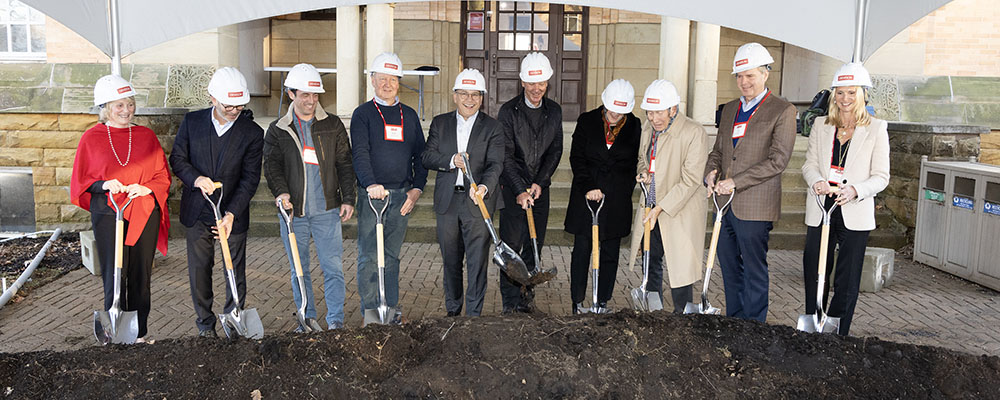
Sherman Fairchild Foundation
A $15 million commitment from the Sherman Fairchild Foundation, which supports a variety of higher education initiatives. The foundation has a history of generosity toward Denison, including a $10 million grant toward global programs and career preparation. Denisonians Wally Burke ’71 (also a Denison life trustee) and President Emeritus Dale Knobel are esteemed leaders of the foundation.
Bob King & Emmy Hauser King ’63
A $5 million commitment from Bob King and Emmy Hauser King ’63. The Kings have been passionate champions of Denison’s innovative career services initiatives. They see this project as “a natural evolution of the groundbreaking work Denison has done to blend the liberal arts with career preparation.” Bob King has built several successful businesses that apply technology to education, including Collegis Education, Deltak, and Rasmussen College. They have dedicated themselves to opening doors to education.
Arthur ’80 & Carrie Steinmetz
A $5 million commitment from Arthur ’80 and Carrie Steinmetz, who are inspired by their belief that “data science skills in a liberal arts context give students powerful tools that set them up well for career success.” Art, a former chairman, CEO, and president of OppenheimerFunds, is a Denison trustee with a bachelor of arts in Russian language and Slavic studies.
Lisa Wolff Brickman ’83 & Daniel Brickman ’80
A $3 million gift from Lisa Wolff Brickman ’83 and Daniel Brickman ’80. With careers in marketing and finance, the Brickmans understand the importance of equipping graduates with both a broad grounding in the liberal arts and leading-edge training in fields like data science. Dan, also a university trustee, has seen firsthand the transformative impact of this combination in the professional world.
Lisa Katz Mathias ’85 & Robert Mathias ’86
A $1 million contribution from Lisa Katz Mathias ’85 and Robert Mathias ’86, who were inspired by Denison’s commitment to a rigorous and relevant curriculum. Rob, a double major in economics and English, credits his Denison experience with helping him build a successful career in investment management. The Mathias’ gift reflects their belief in the power of combining scientific inquiry with creative thinking, a hallmark of Denison’s innovative approach.
Ashley Edwards Bradley ’93 & Thomas Bradley ’91
A generous leadership gift from Ashley Edwards Bradley ’93 and Thomas Bradley ’91. As a Denison trustee and successful entrepreneur, Ashley embodies the versatility a liberal arts education provides. She and her husband, Tom, an executive in private equity, recognize the value of building a purpose-driven facility for data science that will equip Denison students to navigate a complex world.
The Trumbull Family
A $250,000 gift was made by the Trumbull family. The Trumbull family has deep roots at Denison, including Scott ’70, his wife Margy, and their three children, Matthew ’99 and his wife Heather, Benjamin ’03 and his wife Katherine, and Will ’05 and his wife Dana ’04. Scott served on Denison’s Board of Trustees for 26 years, and the family has provided philanthropic support for many of Denison’s strategic priorities, including financial aid and the development of the Trumbull Aquatics Center.
Corrine Brenner Dimitruk ’01 & Michael Dimitruk ’00
Corrine Brenner Dimitruk ’01 and Michael Dimitruk ’00 contributed $100,000 to the project. From the Bay Area, they are proud alums and passionate supporters. Michael, a second-generation Denisonian, is also a member of Denison’s Board of Advisors. Their contribution underscores their commitment to innovation in the liberal arts and reflects their deep connection to the university that shaped their journeys.
